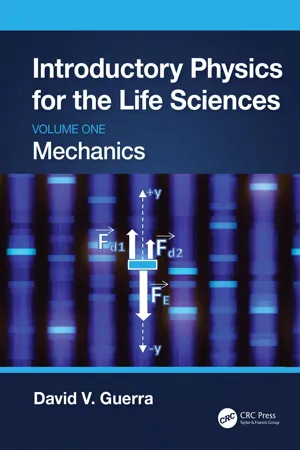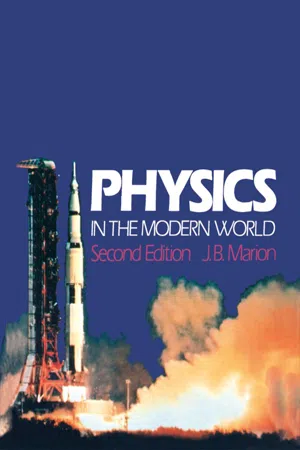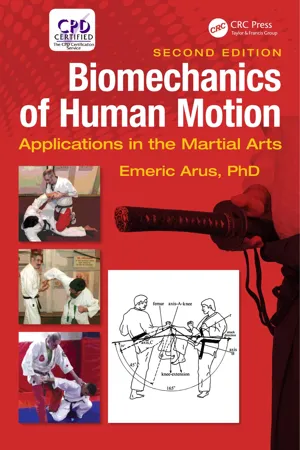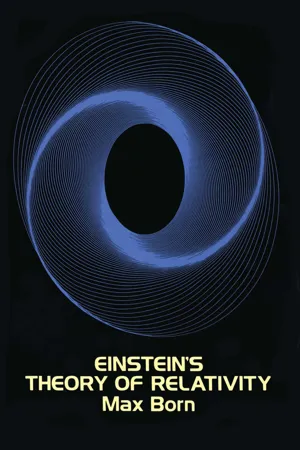Physics
Force and Torque
Force is a push or pull acting on an object, causing it to accelerate or deform. It is a vector quantity, meaning it has both magnitude and direction. Torque, on the other hand, is the rotational equivalent of force, causing an object to rotate around an axis. It is also a vector quantity and is the product of force and the distance from the axis of rotation.
Written by Perlego with AI-assistance
Related key terms
8 Key excerpts on "Force and Torque"
- No longer available |Learn more
- Robert A. Pelcovits, Joshua Farkas(Authors)
- 2023(Publication Date)
- Barrons Educational Services(Publisher)
torque is the ability of a force to cause an object to accelerate angularly (i.e., to rotate at a nonconstant angular velocity). Torque is the angular analog of force. Mathematically,Here r is defined as a relative position vector pointing from the axis of rotation to the point where the force is applied (which requires that torque be calculated about some specified axis). The angle θ is defined as the angle between the position and force vectors when they are placed tail to tail. It makes sense that this cross product determines the rotation that the force imparts:1.Clearly, the rotation produced should be proportional to the magnitude of the force.2.It makes sense that the torque is proportional to the magnitude of r: Forces acting at greater radial distances from the axis (greater “lever arms”) exert more torque. If you don’t believe this, try closing a door by pushing on it close to the hinges.3.The torque also depends on the angle between F and r; torque is maximized when the force is perpendicular to r and is zero when it is parallel or antiparallel. This also makes sense: Try closing a door by pushing or pulling the door away from its hinges.The units of torque are force ⋅ length, generally newton meters (N⋅m).Computing Torque in Problems
1.Magnitude: Recall from Chapter 1 that the magnitude of the cross product is equal to the length of either vector multiplied by the projection of the other vector perpendicular to the first vector. In practice, it is often easiest to calculate the magnitude of the torque this way (designating F⊥ the component of the force perpendicular to r, and r⊥ the component of r perpendicular to F).Based on the situation, it may be easier to compute F⊥ and r or r⊥ and F.2.Direction: - David V. Guerra(Author)
- 2023(Publication Date)
- CRC Press(Publisher)
3 Torque and Rotational Equilibrium
DOI: 10.1201/9781003308065-33.1 Introduction
In some situations, a force is applied using a tool like a wrench or a screwdriver and a twisting force, called a torque, is produced. These twisting forces are central to the understanding and analysis of some objects in equilibrium. In this chapter, the concepts of torque will be studied and then applied to the analysis of systems in rotational equilibrium.- Chapter question: A person suspends a block of mass m from his or her hand, as depicted in Figure 3.1 .
FIGURE 3.1 Diagram of an arm.Assuming their forearm has a mass mA , is the force of tension in their bicep muscle equal to, greater than, or less than the sum of the weight of their arm and the weight of the object? To answer this question, the concepts of torque and rotational equilibrium will be developed and they will be applied at the end of this chapter to answer this question.
3.2 Torque
Torque is a twisting force, which is denoted by the Greek letter tau (τ). When opening the lid of a jar, the more force you apply the more twisting force (torque) you apply to open the jar. As you may also know from experience, if you are trying to loosen or tighten a bolt with a wrench, the harder you pull on the wrench, the force (F), the more torque there is on the bolt. But sometimes the bolt will not loosen no matter how hard you pull on the wrench. To loosen the bolt you can get a longer wrench or even slip a pipe on the end of the wrench. So, it is clear that the torque depends not only on the force applied but also on the distance away from the rotation point at which the force is applied.In the previous example, the angle between the force and the distance away from the rotation point is assumed to be perpendicular as shown in Figure 3.2 , but that is not always the case. So, the torque (τ) is defined as the product of the applied force (F) and the perpendicular distance (r ⊥- eBook - ePub
- Craig Williams, David James, Cassie Wilson(Authors)
- 2008(Publication Date)
- Routledge(Publisher)
The effect of force is observed through changes in motion, and hence Newton’s laws of motion are important in understanding the effect of force. However, Newton’s laws are only valid for rigid bodies, so application of these laws to the human body should be performed cautiously. Force is the product of mass and acceleration of an object. When forces are generated by muscle contraction in the human body, it is normally torque about a joint that is measured. Functionally torque is important since it is the product of the force applied and the perpendicular distance between the joint and the point of application of the force. Whilst force can be applied to solid objects only, pressure (i.e. force per unit area) can be applied to both solids and fluids (i.e. liquids or gases). With regard to exercise and sport, the time over which force is applied is important, and is known as impulse. Knowledge of the impulse–momentum relationship is vital in understanding sports technique. In an exercise and sport laboratory, force may be measured between an object and the ground through the use of a force plate. Additionally, torque about a joint can be measured when the muscle is working isometrically, isokinetically or isotonically through the use of an isokinetic dynamometer.KEY POINTS- The effect of force is observed through the change in motion of an object.
- Force is equal to the product of the mass and acceleration of an object.
- Newton’s first law of motion is the law of inertia: a force is required to stop, start or alter motion of an object.
- Newton’s second law of motion is the law of acceleration: the acceleration of an object is proportional to the force acting on it, and takes place in the direction of the force.
- Newton’s third law of motion is the law of action–reaction: to every action created by a force, there is an equal and opposite reaction.
- The duration over which a force acts is functionally important, and is known as impulse.
- Pressure is force per unit cross-sectional area.
- Pressure can act on all states of matter, but only on liquids and gases if they are contained.
- Force can be measured using a force plate.
- Torque is the force operating about a point of rotation, and is calculated as the product of the force and the perpendicular distance between the point of rotation and the point of force application.
- Torque is functionally important in exercise and sport since force is applied in the human body through a series of levers.
- Joint torque–velocity relationships give a functional insight into muscle forceshortening velocity relationships.
- The impulse–momentum relationship is a cause and effect one, whereby a correction of momentum can be achieved by modifying the impulse being applied.
BIBLIOGRAPHY
Astrand, P-O. and Rodahl, K. (2003) Textbook of Work Physiology: Physiological Bases of Exercise - eBook - ePub
- Jerry Marion(Author)
- 2012(Publication Date)
- Academic Press(Publisher)
θ .FIGURE 5-8 The torque exerted on the ball and rod by the gravitational force depends on the angle θ. Notice that in the horizontal position, θ = 90°; because sin 90° = 1, the torque is J = mgr .Couples
We have learned that if the net force on an object is zero, then the acceleration experienced by the object is also zero. When discussing such situations we have always pictured the forces acting at the same point on the object (see, for example, Fig. 3-2 ). Suppose, however, that we allow two forces with equal magnitudes and opposite directions (so that F net = 0) to act at different points on an object. This situation is shown in Fig. 5-9 . Each force acts at a distance r from the center of the rod (point P ) and the direction of each force makes an angle θ with the direction of the rod. We can see that each force exerts a torque J = rF sin θ around point P . Because each torque produces a rotation in the same direction, the two effects add. But we still have F net = 0, so that there is no net translational motion of the rod; that is, the point θ remains in the same position. Two forces that act together to produce rotation but no net translational motion are called a couple .FIGURE 5-9 The force pair F 1 and F 2 constitute a couple , which produces rotation but no net translational motion (because F 1 + F 2 = 0).5-3 CENTER OF MASS
A Uniquely Useful Point
In Section 2-7 we discussed the motion of an object thrown into the air with some horizontal velocity component. Such motion takes place along a curved path (a parabola ). This parabolic motion is easy to visualize and understand for a small object or particle. But what about the motion of an object with a complicated shape? The tip of a football, for example, undergoes an intricate rolling motion when the football is kicked end over end. A simpler case is shown in Fig. 5-10 . Here, we have two balls with unequal masses attached by a thin, rigid rod. When this out-of-balance dumbbell is thrown into the air, the path of each ball is a looping curve; neither ball moves on a parabolic path (shown by the dashed curve in Fig. 5-10 ). There is one point on the dumbbell, however, that does move along the parabola. This point is located on the connecting rod and does not correspond to either the small or the large ball. If we were to focus on this point and ignore the rest of the dumbbell, we would see the exactly parabolic path that our simple analysis predicts (for the case of no air resistance). This unique point in the object which follows the predicted parabolic path is called the center of mass - eBook - ePub
- A. L. Stanford, J. M. Tanner(Authors)
- 2014(Publication Date)
- Academic Press(Publisher)
F isFigure 4.13 A force F applied to a body. The force acts at a distance r from the axis of rotation.τ = r F ⊥ = r F sin θ(4-29)(4-29)Torque is a vector quantity with a magnitude given by Equation (4–29) . The definition of the torque τ produced on an object about an axis by a force F applied to the object at a point located by r from that axis isτ = r × F(4-30)(4-30)The direction of τ is perpendicular to the plane containing r and F and is specified by the right-hand rule: When the fingers of the right hand are curled from the direction of r toward the direction of F , the extended thumb of that hand points in the direction of τ.We may note from Equation (4–29) that the magnitude of the torque produced by a force depends on: (a) the magnitude F of the force; (b) in what direction (θ) that force acts; and (c) where (r ) on the body, relative to the chosen axis, that force is applied.From either of Equations (4–29) and (4-30) we may see that the unit of torque is a product of a unit of force and a unit of length. In the SI system, the unit of torque is the newton-meter (N · M); in the English system the unit of torque is the pound-foot (lb · ft).E 4.15
A rectangular sheet of plywood is to be rotated about an axis perpendicular to the sheet and through point A , as shown in each of the accompanying figures. Each figure shows a 5.0-N force acting on the plywood. For each situation, determine the magnitude and sense (clockwise, CW; or counterclockwise, CCW) of the torque about the axis A - eBook - ePub
Biomechanics of Human Motion
Applications in the Martial Arts, Second Edition
- Emeric Arus, Ph.D.(Authors)
- 2017(Publication Date)
- CRC Press(Publisher)
The kilogram (kg) is an SI base unit of mass. From here results that a mass of 1 kg = 9.8 m/s 2. A man of 70 kg mass × 9.8 m/s 2 will have 686 Newton force. 8.2 FORCES Recall that kinetics deal with motion that includes the forces that cause the motion. The physical property of the force, perhaps, is the most important between other physical properties, such as momentum, impulse, energy, velocity, and so on, which are related to objects in static positions or dynamic motions, including humans and animals alike. Force is described as the effect one object has on another, which can alter the state of a matter by pushing, pulling, twisting, sliding, and so on, and this effect of the force (F) is the product of a mass and its acceleration F = m ⋅ a. There are many different kinds of forces such as internal forces; for example, in biomechanics, a muscle contraction produces internal forces that move a segment of the body. External forces represent actions on the system of the human body such as a pushing, pulling, or twisting force or even push of the wind. The gravity and inertial forces have been described in Chapter 6. Force is a vector quantity that includes magnitude and direction. The force of action usually includes a point and a line of application. The force vector is represented by an arrow, usually a straight line from the origin of the force that shows the direction of the force and the length of the arrow represents the magnitude of the force. Other vector quantities are velocity, acceleration, momentum, torque, and impulse. In the human body, the force is represented by the skeletal muscle. A specification that is important to be mentioned here is that muscles can execute only pulling actions. To better understand the pulling actions of the muscles, here is the explanation: When you pull a cart, you say there is a pulling action of the biceps muscle. But when you push a table, you probably will say there is a pushing action - eBook - ePub
- Max Born(Author)
- 2012(Publication Date)
- Dover Publications(Publisher)
CHAPTER II THE FUNDAMENTAL LAWS OF CLASSICAL MECHANICS 1. Equilibrium and the Concept of Force Historically, mechanics took its start from the doctrine of equilibrium, or statics; the development from this point is also the most natural one logically. The fundamental concept of statics is force. It is derived from the subjective feeling of exertion experienced when we perform work with our bodies. The stronger of two men, we say, is the one who can lift the heavier stone or stretch the stiffer bow. This measure of force, with which Ulysses established his right among the suitors, and which indeed plays a great part in the stories of ancient heroes, already contains the germ of the objectivization of the subjective feeling of exertion. The next step was the choice of a unit of force and the measurement of all forces in terms of their ratios to this unit, that is, the relativization of the concept of force. Weight, being the most evident manifestation of force, and making all things tend downwards, offered the unit of force in a convenient form—a piece of metal which was chosen as the unit of weight through some decree of the state or of the Church. Nowadays it is an international congress that fixes the units. In technical matters, the unit of weight today is the weight of a definite piece of platinum which is maintained in Paris. This unit, called the pond (p) will be used in our discussion till otherwise stated. The instrument used to compare the weights of different bodies is the balance. Two bodies have the same weight, or are equally heavy, when on being placed in the two scales of the balance they do not disturb its equilibrium. If we place these two bodies in one pan of the balance, and in the other a body such that the equilibrium is again not disturbed, this new body has twice the weight of either of the other two - eBook - ePub
- Hiqmet Kamberaj(Author)
- 2021(Publication Date)
- De Gruyter(Publisher)
Newton was able to answer the question of what force causes the planets to orbit around the Sun, and related questions by stating that forces are what cause any change in the velocity of an object. Thus, no force is required for the motion with a constant velocity of an object to be maintained. For example, the Moon’s velocity is not constant because it moves in a nearly circular orbit around the Earth because of the force exerted on the Moon by the Earth. Therefore, since the velocity of objects changes whenever a force is applied to them, then the forces make the objects accelerate. Here, we are concerned with the relationship between the force exerted on an object and the acceleration of that object.Equilibrium
In the case when more than one force acts upon an object simultaneously, if the net force acting on it is different from zero, then the object accelerates. By definition, the net (or resultant) force acting on an object is given by the vector sum of all vectors of the forces acting on the object:(5.1)F R=∑ iF iwhereF Ris the net force as the over all force, the resultant force, or the unbalanced force, and the sum runs overall forcesF iacting upon the object. If the resultant force,F R, exerted on an object is zero, then its acceleration is zero, and hence the velocity of that object remains unchanged. In other words, if, then the object either remains at the state of rest or continues moving with the same velocity. If an object moves with constant velocity or it is at rest (that is, its velocity is zero), the object is said to be in equilibrium.F R= 0When a coiled spring is pulled, as in Fig. 5.1 , the spring stretches and hence changes its state of rest. That is the case of contact forces.Figure 5.1 Example of applied contact force.To overcome the conceptual problem of non-contact forces, Michael Faraday (1791–1867) introduced the concept of a field. Based on this concept, if any object is placed near another object, then the objects interact with each other through the gravitational field. In this case, we say that a gravitational field is created by each object at the position of the other object. All objects create a gravitational field in the space around themselves. Field forces are those types of forces, which do not have physical contact between two objects, but they are acting through empty space. An example of the field force is the gravitational attraction force between two objects, illustrated in Fig. 5.2
Index pages curate the most relevant extracts from our library of academic textbooks. They’ve been created using an in-house natural language model (NLM), each adding context and meaning to key research topics.







